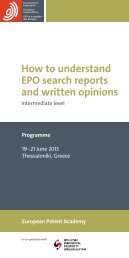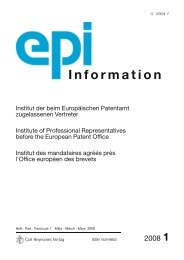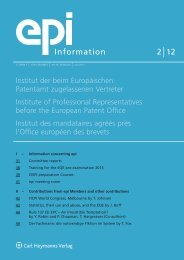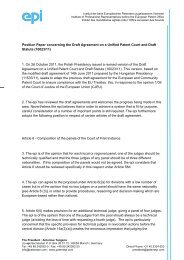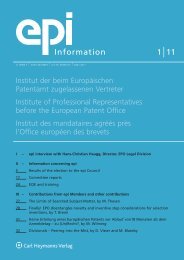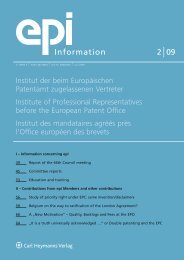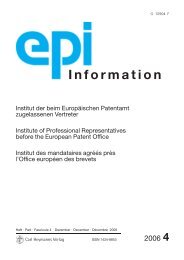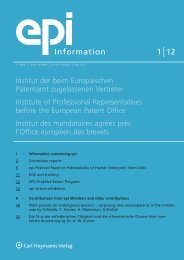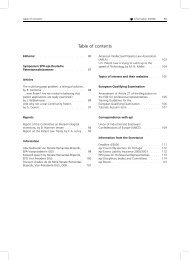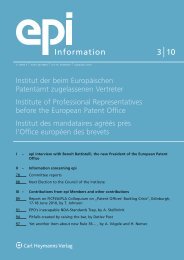130 Articles <strong>Information</strong> 4/<strong>2010</strong>disclosure is that in the latter case the skilled personalready knows the contents of the patent application inquestion, whereas in the first case such content isunknown to him 5 . The closest prior art and the technicalproblem to be solved therefore are of no relevance whenpondering sufficiency of disclosure. In addition, the solutionprovided by the invention may be taken from adifferent technical field compared to the field of theclosest prior art (as analysed with respect to inventiveness).For this reason, the skilled person constructed inthe process of deciding on inventiveness may have a verydifferent common technical knowledge compared to theskilled person in the field the invention is taken from 6 .Moreover, industry standards being day-to-day businessof the first skilled person may be unknown to or notsufficiently comprehended by the second skilled person.Thus, the mere label „industry standard“ does not entaila guarantee that a technical teaching is sufficiently disclosedaccording to the relevant skilled person’s judgement.The Boards of Appeal would still have to consider ifthe specifications provided by a standard are sufficient toenable the skilled person to carry out an invention. Even ifproducts according to a standard had been available onthe market for a long time before the relevant date of thepatent application, this cannot be as such indicative thatthe average skilled person would be able to transfer anyprior knowledge to the special circumstances of aninvention. It should not be forgotten that by its verydefinition an invention surpasses the average skilledperson’s abilities. Concluding, sufficiency of disclosurehas to be decided on a case by case basis even ifapplicants claim that by reference to an industry standardthe invention has been sufficiently disclosed.3.3. Another requirement imposed by Art. 83/100 bEPC is that it is forbidden to impose an „undue burden“on the skilled person when trying to carry out theinvention. The degree of detail required by a patentapplication or patent document, respectively, to avoidundue burden has to be judged in view of the inventionin question. A rough outline of an invention may besufficient in one case, e.g. when a problem can surprisinglybe solved by means already familiar to the skilledperson in some other context, whereas a plethora ofexamples and instructions may be required in othercases, e.g. where the standard merely consists of acompilation of requirements, leaving it to the skilledperson to develop by himself means for living up to theserequirements in the frame of the invention in question.Again, just referring to an „industry standard“ may ormay not provide the skilled artisan with enoughinformation to carry out the invention.5 cf. also T 694/92, section 76 The thesis that the standard for the skilled person’s knowledge is generallythe same for the requirements of inventive step and sufficiency of disclosureis thus untenable. The mistake seems to result from a translation errorconcerning decision T 60/89, section 3.2.5, which unfortunately has alsocrept into the German version of the „Caselaw book“. The Board held – inthe language of the proceedings – that the same level of skill has to beapplied when, for the same invention, the two questions of sufficientdisclosure and inventive step have to be considered. This was erroneouslytranslated into „der gleiche Wissensstand“, i. e. the same knowledge.But even disregarding difficulties in understanding thespecifications of an „industry standard“, undue burdenmay also be imposed circumstantially. This is an importantdifference when comparing state of the art-relatedobstacles to patenting like novelty and inventive stepwith the requirement of sufficient disclosure. Even gravedifficulties of finding and accessing a document are of nointerest for qualifying a document as prior art 7 . Contraryto this, such difficulties may result in the very samedocument being left out of consideration when ponderingsufficiency of disclosure. The inventor shall not berewarded for cunningly hiding key teachings of theinvention in documents unduly difficult (or costly 8 )toobtain, as such behaviour would again not be commensurateto the scope and ease of protection granted by apatent. Otherwise the inventor could profit twice: Hewould own a patent, and he could make a fortune byselling the necessary instructions to carry out the invention.If such sales were made under a non-disclosureagreement, he could even continue to sell the instructionslong after the patent itself has expired. As Stellbrinkcorrectly points out, once the level of detail of suchinstructions is sufficient, these instructions could not bedeveloped a second time by another party without anycriminal offence.It may be surprising that mere formalities like themode of access to information could influence thedecision on enabling disclosure 9 . However, it should beremembered that Art. 83/100 b EPC stipulates that theinvention should be disclosed clearly and completely inthe application or patent document, and anything reliedupon other than the literal content of the applicationdocuments or patent document needs justification to betaken into consideration. It would therefore be up to theadvocates defending the righteousness of relying onstandards subject to non-disclosure agreements andsubject to the need for obtaining a licence to showconvincingly how the intention underlying the EPC couldbe achieved, which is that all inventions shall becomefree art in their entirety („clear and complete“) once thecorresponding patents lapse. In particular, the Boards ofAppeal may consider that requiring the skilled person toobtain a license before disclosing the invention clearlyand/or completely to him generally puts him under apersistent obligation 10 to pay royalties, to grant thirdparty accounting experts access to his business records,and maybe even to abstain from invalidating patentsheld by the licensor or other licensees. Such obligationsmay be considered an undue burden for a skilled person7 T 165/96, section 1.1.1.48 This was deliberately left undecided in T 82/07, section 6.5. DecisionsT 50/02 and T 1030/00 do not seem to be applicable, as they are onlyconcerned with the question of whether or not a document belongs to thestate of the art. Stellbrink himself argues (correctly) that „state of the art“ isnot a subject of Art. 83 EPC.9 It is important to note that decision T 50/02 does not stand in the way of suchconsiderations. That decision was concerned with defining the prior art; it didnot attempt to abolish the established bar against undue burden withregards to enabling disclosure.10 This is clearly different from other industry standards, e.g. those proclaimedby ISO or DIN. Even though such standard specifications also can only beobtained from one or few sources, any person interested in such standardmerely has to buy a copy thereof.
<strong>Information</strong> 4/<strong>2010</strong> Articles 131who merely tries to carry out an invention, particularlywhen the patent pertaining to the invention has lapsed.And promising that licenses will be dispensed on everyinterested party does not vindicate from allegations thatthe licensing conditions (or the very requirement ofhaving to ask for a licence) impose an undue burden.4. The means for sufficient disclosure4.1. It is thus necessary to pay attention to the meansallowable under the EPC for disclosing an invention.Obviously, nothing can go wrong when the invention isdisclosed sufficiently clearly and completely in the originalapplication documents and the patent document,respectively. However, this is not possible for such inventionswhich have to rely to a significant extent onteachings subject to a non-disclosure agreement.4.2. Stellbrink also considers that „a reference to adocument [is] sufficient to provide an enabling disclosure“,and indeed such references are commonly used toaugment the literal content of application documents.However, this strategy is only successful when certainadditional conditions established by the Boards ofAppeal 11 are met. Some of these conditions prima faciemay be difficult to comply with in cases as described byStellbrink:First, it is indispensable that the document referred tocan be unambiguously identified. This can be a problemparticularly where the document contents are allowed tochange over time, e.g. when some parts of an industrystandard specification are made obsolete or are otherwiseamended in a revision of the standard.Second, the document referred to must have beenavailable to the EPO on the date of filing 12 , and to thegeneral public upon publication of the application at thelatest 13 . Now it is at least doubtful that a licensor – whoconsistently requires his licensees to accept a non-disclosureagreement – would at all be inclined to grant alicense to the EPO, whose obvious intention is to makethe licensed standard known to prospective patentapplicants, e.g. in search reports 14 ; and according tothe facts of T 82/07 (section III), the Office has alreadytried in vain to obtain a copy of the DVD standardspecifications 15 . However, and insofar I agree with Stellbrink,the inability of the Office to get hold of some11 The Enlarged Board of Appeal have so far refused to give a ruling in suchmatters. For a discussion of „incorporation by reference“ during analysis ofadmissibility of amendments, see e.g. T 374/96, section 5.12 T 737/90, section 413 T 429/96, section 414 certainly the EPO cannot rely on examiner affidavits as a substitute to thepresentation of relevant prior art to the applicant15 In fact, the EPO was informed by DVD FLLC that „execution of the nondisclosureagreement is limited to private companies that can vigorouslyprotect the confidentiality of the Proprietary <strong>Information</strong> in the DVD Books“.In addition certainly the EPO could not rely on laws regarding unfaircompetition or cartels to get access to the DVD standard specifications.And given the information of DVD FLLC, it is highly questionable if indeedevery interested skilled person would readily be granted such access: TheDVD FLLC seems unwilling to grant access to self-employed engineers andscientists in public institutions (cf. summons in appeal regarding applicationEP98302034).document is not indicative for a corresponding inabilityof the skilled person. But matters being as they are, thefacts discussed above at least do not readily support theassumption that the second criterion actually is met inthe DVD standard case.Third, the document referred to must have beenavailable „easily“, i. e. without undue effort. Thisrequirement again has to be analysed on a case by casebasis, as was emphasised by section 5 of decisionT 737/90 16 . As discussed above, there are some argumentsavailable indicating that access to an industrystandard subject to licensing and non-disclosure requirementsshould not be considered „easy“. And given thevolume of the DVD standard, the Boards of Appeal mayconsider that undue effort is required to find the relevantsection of the standard applicable to the invention.Thus, it is by no means a foregone conclusion that anyreference to a document is sufficient to provide anenabling disclosure.4.3. As a last resort an inventor may appeal to the skilledperson’s general knowledge. Certainly, the skilled personneeds not be taught what he already effortlesslyknows to do. However, any appeal to the general knowledgeleads again to the problem of defining the skilledperson. According to Stellbrink, the skilled person in thefield of digital storage media may well not have comeinto contact with – let alone know effortlessly – theexact specifications of the DVD standard. In the absenceof convincing arguments that „the“ skilled person willconsider the DVD standard part of his general knowledge,such appeal must fail.5. An exception for industry standards?Stellbrink argues that it would be in the European patentsystem’s own interest to impose less stringent conditionson inventions that have to rely on an industry standardsubject to a non-disclosure and license agreement. Afterall, the inventor generally has not chosen to impose suchcurfew; instead, he is a victim of the restrictions himself.And if inventors are prevented from obtaining patentsfor their inventions in the field of such industry standards,then this would result in an unnecessary impedimentto the advancement of the arts: As inventorscannot hope to capitalise on their innovations, they willturn to some other technical field. In addition, industrystandards may not even contain any above-average„progress“ at all, so they should not be able to blockinnovations from patent protection.These arguments, interesting as they are, cannotpossibly justify an exception for „industry standard relatedinventions“ from the requirements of sufficiency of disclosureapplied to any other invention. First of all, how is anindustry standard eligible for privileged (i. e. limited) examinationto be defined, and who is to decide in case an16 affirmed e.g. by T 429/06, section 5. See T 276/99for a decision particularlyemphasising that not disclosing something critical for the invention in apatent specification may impose a burden contrary to the provisions ofArt. 83 EPC



